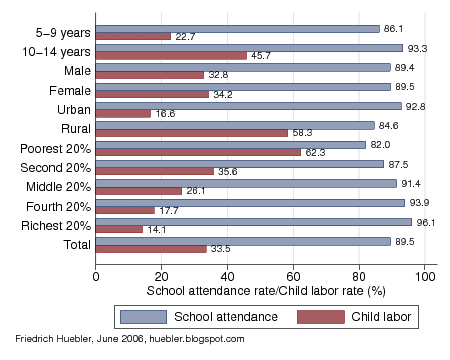Child labor can harm a child's health and, even if not harmful, it can interfere with school attendance. The latest data on school attendance for Bolivia comes from a Demographic and Health Survey (DHS) conducted in 2003/04. The DHS did not collect data on work by children but such data is available from a Multiple Indicator Cluster Survey (MICS) that was carried out in 2000.
The graph and table below present the share of children aged 5 to 14 years who attend school or are engaged in child labor. School attendance is defined as attending any level of education at the time of the MICS survey, from preschool over primary to secondary school. Child labor is defined as any economic work during the week of the survey, or more than two hours of domestic work per day. Economic work includes paid or unpaid work for someone who is not a member of the household, and paid or unpaid work for a family farm or business. Domestic work covers activities like cleaning, cooking, shopping, or caring for other children.
School attendance and child labor, children 5-14 years, Bolivia

Data source: Bolivia 2000 MICS.
In total, 89.5 percent of all children between 5 and 14 years are in school and 33.5 percent are engaged in child labor. Older children are more likely to go to school or work than younger children. There is no difference between boys' and girls' school attendance rates but slightly more girls are engaged in child labor. There are clear differences between children from urban and rural areas, especially with regard to child labor. 92.8 percent of all urban children go to school and only 16.6 percent are in child labor. In rural areas, 84.6 percent are in school and more than half of all children, 58.3 percent, are child laborers.
There is also a clear association between household wealth and school or work. Of all groups, children from the poorest 20 percent of all households have the lowest school attendance and highest child labor rates: 82.0 percent are in school and 62.3 percent at work. In contrast, children from the richest 20 percent of all households are most likely to be in school and least likely to work: 96.1 percent of these children attend school and only 14.1 are engaged in child labor. School attendance rates increase steadily with household wealth, while child labor rates decrease.
School attendance and child labor, children 5-14 years, Bolivia 2000
| School attendance (%) | Child labor (%) | |
| 5-9 years | 86.1 | 22.7 |
| 10-14 years | 93.3 | 45.7 |
| Male | 89.4 | 32.8 |
| Female | 89.5 | 34.2 |
| Urban | 92.8 | 16.6 |
| Rural | 84.6 | 58.3 |
| Poorest household quintile | 82.0 | 62.3 |
| Second household quintile | 87.5 | 35.6 |
| Middle household quintile | 91.4 | 26.1 |
| Fourth household quintile | 93.9 | 17.7 |
| Richest household quintile | 96.1 | 14.1 |
| Total | 89.5 | 33.5 |
Related articles
- Child labor and school attendance in Bolivia, part 2
- Child labor and school attendance
- Child labor: economic activity and household chores
- Primary school attendance in Bolivia
- Secondary school attendance in Bolivia
- Education data from household surveys
- UNICEF priority countries for girls' education
- Household wealth and years of education
Permanent URL: http://huebler.blogspot.com/2006/06/child-labor-and-school-attendance-in.html